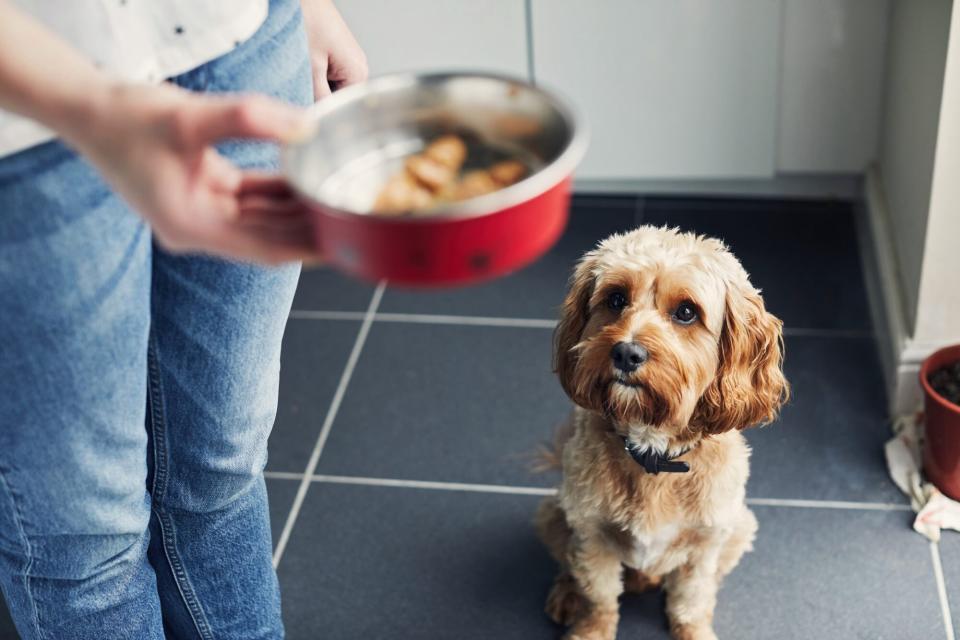How Much Should I Actually Be Feeding My Dog?
If you've adopted a puppy, rescued a senior, or are starting a new relationship with a dog you just brought home the fun has just begun. It's a joyous time at your house filled with firsts and lots of questions, like how much should I feed my dog?
While you're likely to get all kinds of advice from everyone from the breeder or shelter to your veterinarian or well-meaning friends, the answer may be as simple as looking closer at your food's packaging. A great place to start is by looking at the back of your dog food packaging, suggests Dr. Callie Harris, a veterinarian at Purina who is based in Atlanta.
Read the Charts
Each dog food manufacturer provides a feeding chart. "The layout of the chart, however, can vary from brand to brand so if you're switching brands, pay close attention to ensure you're feeding your dog the correct amount based on his weight," says Dr. Harris. What's more, most charts list daily intake, so if you're feeding twice per day, don't forget to divide the recommended amount in half.
Touch base with your vet to check in on how much you're feeding. They're great resources who can let you know if the amount seems reasonable. Finally, take into account your dog's activity level and lifestyle. If you have an older, couch potato basset hound you may need slightly less food than the recommended amount on the dog food package. If you have a high-energy Jack Russell terrier, you may need slightly more food than the manufacturer recommends.

Getty Images
How to Tell If Your Dog Might Be Overeating
"There are no average dogs, but an average dog weight will differ with breeds," explains Dr. Harris. She recommends using the "healthy hug" technique to determine if your dog is overweight. "You should be able to lightly run your hands alongside his body and easily feel his ribs. You should also be able to look at your dog from the side and see an abdominal tuck as well as stand above him and visualize a waist."
How Much Do You Need to Feed a Puppy
If you're welcoming a puppy into your family, select a high-quality puppy food formula. You want to make sure your selection provides your new pup with the nutrition she needs to get a head start toward a lifetime of health. "Puppies' growing bodies need 25 percent more protein, 54 percent more fat, and 140 percent more calcium than adult dogs," says Dr. Harris. That's a lot!
Feed your new addition puppy food for her first year if she's an average size breed. According to The Association of American Feed Control Officials (AAFCO), large breed puppies need this level of nutrition up to 24 months. Because puppies pack all their growth into 1-2 years, they have specific nutritional requirements that help support their rapid growth and development.
What if You Rescued a Dog That's Underfed?
It's not uncommon for rescue dogs to resist eating when you first bring them home, warns Dr. Harris. They are getting used to a new home, new smells, and a new family so it can be a little overwhelming. "Remember that feeding your pet is a great bonding experience so make mealtime fun with a few treats and enticing with highly palatable dog food," she says.
Although it's tempting to shower an underfed dog with loads of treats and people food, resist the urge. "Even if your dog is underweight, treats should make up no more than 10 percent of their daily caloric intake. Otherwise, they might put on too much fat and not enough muscle," says Dr. Harris.
If your rescue pup isn't eating his food once he settles in, you should visit your veterinarian to rule out any illnesses.
What if your Dog is Overweight?
If you have an overweight pup, there are things you can do to try to help him reduce weight.
Keep excess treats and people food to a minimum.
Try switching your dog food to a weight management formula.
Consult with your vet about a good weight management plan.
Incorporate more exercise into your pup’s daily life.
If you have a chubby puppy, talk to your vet before making any dietary changes. "Puppies are still in their growth phase and it's important to ensure that their food contains the nutrients they need in appropriate amounts such as DHA, antioxidants, protein, calcium, and phosphorus," says Dr. Harris.
Mealtime should be a predictable, happy, and calm experience at your house—sort of like the way families enjoy dinner at the dinner table. If you have any questions about what or how much to feed your dog, talk to your vet.

